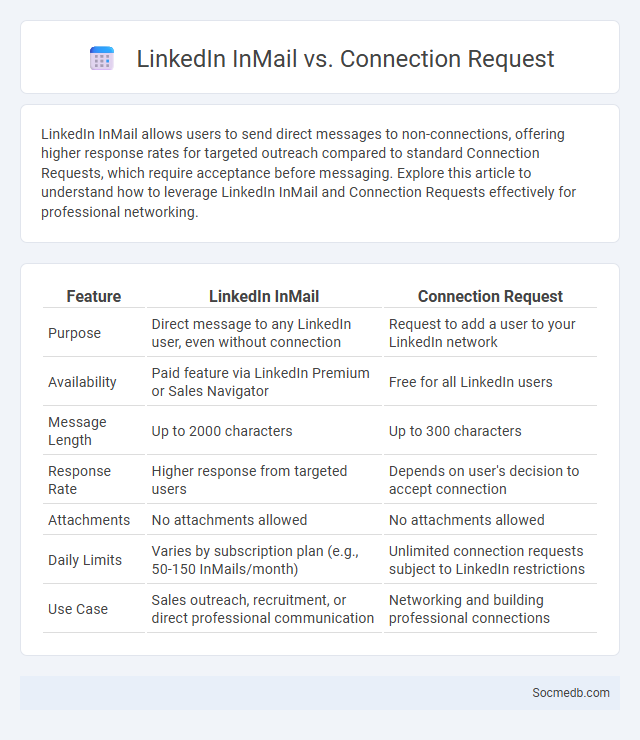
Photo illustration: LinkedIn InMail vs Connection Request
LinkedIn InMail allows users to send direct messages to non-connections, offering higher response rates for targeted outreach compared to standard Connection Requests, which require acceptance before messaging. Explore this article to understand how to leverage LinkedIn InMail and Connection Requests effectively for professional networking.
Table of Comparison
| Feature | LinkedIn InMail | Connection Request |
|---|---|---|
| Purpose | Direct message to any LinkedIn user, even without connection | Request to add a user to your LinkedIn network |
| Availability | Paid feature via LinkedIn Premium or Sales Navigator | Free for all LinkedIn users |
| Message Length | Up to 2000 characters | Up to 300 characters |
| Response Rate | Higher response from targeted users | Depends on user's decision to accept connection |
| Attachments | No attachments allowed | No attachments allowed |
| Daily Limits | Varies by subscription plan (e.g., 50-150 InMails/month) | Unlimited connection requests subject to LinkedIn restrictions |
| Use Case | Sales outreach, recruitment, or direct professional communication | Networking and building professional connections |
Understanding LinkedIn Messaging Options
LinkedIn offers various messaging options that cater to professional networking, including InMail for contacting users outside your connections and direct messages for connections within your network. You can customize communication through text, attachments, and emojis, enhancing engagement and clarity. Optimizing your LinkedIn messaging strategy boosts your outreach effectiveness and strengthens your professional relationships.
What is LinkedIn InMail?
LinkedIn InMail is a premium messaging feature allowing you to directly contact professionals outside your immediate network on LinkedIn. It enables personalized communication for networking, recruitment, or business opportunities, bypassing the limitations of standard connection requests. This tool enhances your outreach strategy by increasing response rates and fostering meaningful professional relationships.
What is a LinkedIn Connection Request?
A LinkedIn connection request is an invitation sent by a user to another professional to join their network, enabling direct communication and access to shared content. It serves as a foundational tool for expanding Your professional relationships and enhancing networking opportunities within industries. Accepting a connection request unlocks messaging features and visibility into each other's endorsements, recommendations, and shared connections.
InMail vs. Connection Request: Key Differences
InMail on LinkedIn allows users to send direct messages to any member outside their network, providing a powerful tool for targeted outreach and professional communication. Connection Requests require mutual acceptance before messaging is possible, fostering closer relationships but limiting initial contact to known or trusted connections. InMail typically has higher costs and response rates, while Connection Requests offer organic network growth with more selective engagement.
When to Use InMail on LinkedIn
InMail on LinkedIn is most effective when reaching out to professionals outside your immediate network, particularly for networking, recruiting, or sales purposes. Use InMail to send personalized, targeted messages that stand out compared to standard connection requests, increasing the likelihood of engagement. Leveraging LinkedIn's advanced search filters beforehand ensures your InMail reaches the most relevant recipients, maximizing response rates and professional connections.
Effective Use of Connection Requests
Maximize your networking potential by personalizing connection requests on social media platforms like LinkedIn, which boosts response rates by up to 40%. Clearly state the purpose and mutual benefits in your message to establish trust and relevance. You can build stronger professional relationships by targeting connections with shared interests or industry backgrounds.
Pros and Cons of LinkedIn InMail
LinkedIn InMail offers a powerful way to reach potential clients, partners, or employers directly, increasing your networking opportunities and response rates compared to regular messages. On the downside, it can be costly, with limited InMail credits that might restrict outreach for users on basic plans. Your success with LinkedIn InMail depends on crafting personalized, relevant messages to avoid being ignored or marked as spam.
Pros and Cons of Connection Requests
Connection requests on social media enable users to expand their professional and personal networks, facilitating opportunities for collaboration, job hunting, and information sharing. However, an influx of unsolicited connection requests can lead to privacy concerns, spam, and reduced trust in network authenticity. Effective management of connection requests depends on using platform privacy settings and selective acceptance to balance opportunities with safety.
Best Practices for LinkedIn Outreach
Effective LinkedIn outreach hinges on personalized connection requests that highlight shared interests or mutual contacts, ensuring higher acceptance rates. Crafting concise, value-driven messages tailored to the recipient's professional background enhances engagement and fosters meaningful conversations. Consistent follow-ups spaced appropriately prevent solicitation fatigue while maintaining relationship-building momentum on the platform.
Choosing Between InMail and Connection Request
Choosing between LinkedIn InMail and connection requests depends on your outreach goals and relationship with the recipient. InMail offers direct messaging to users outside your network, increasing the chance of your message being noticed, while connection requests foster a more personal link by initiating mutual connections. Your strategy should balance targeted communication with relationship-building to maximize engagement and response rates.
 socmedb.com
socmedb.com